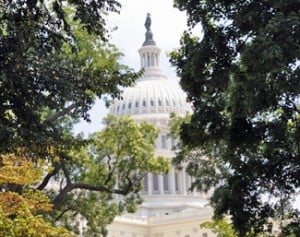
The U.S. Capitol building (Photo by Heath Haussamen)
President Obama and Rep. Paul Ryan have now put forth dueling budget proposals, at least in theory to address America’s unsustainable budgetary situation, which has worsened dramatically over the past decade. When Bill Clinton left office, annual federal spending was “only” $1.8 trillion. In the last 10+ years, federal spending has doubled to more than $3.8 trillion.
Both parties have outlined proposals that have worthwhile elements, but at the same time, both avoid making some tough, but necessary, cuts to the federal leviathan.
Cutting military spending
President Obama should be applauded for – despite opposition from many in his party – at least tackling the issue and for bringing forth the outlines of a plan. While his tax hikes are far more specific than his spending cuts, Obama is attempting to appear to be serious about taxes and spending. And he should be applauded for at least placing military spending on the chopping block (unlike Ryan’s plan).
Unfortunately, Obama’s military spending “cuts” are wholly inadequate. America spends $700 billion annually on defense – more than four times the amount spent by China and Russia combined. The United States currently maintains dozens of bases, ostensibly to defend such wealthy nations as Germany, England, Italy, and Japan (to name just a few).
Surely we can cut more than the $400 billion Obama wishes to cut (a mere $33 million annually) from military spending by 2023.

Paul Gessing
Overhauling entitlements
Paul Ryan’s budget has a lot more to like than Obama’s, but it is by no means perfect either. For starters, Ryan fails to even put defense spending on the table. But, unlike Obama’s budget, Ryan seriously tackles entitlements (Medicare and Medicaid, albeit not Social Security).
Medicare, an “entitlement” program that faces unfunded liabilities (that is money owed that we have no way to pay) of $74 trillion, would be transformed to a more market-friendly system. Instead of the government reimbursing doctors and hospitals for certain medical services, seniors would purchase a private health care plan among numerous options. The government would then pay the private insurer in the form of a subsidy up to a specified amount.
This provision would increase help for the sick and poor while shifting more cost to wealthy seniors. Far from clobbering seniors (as Obama and many on the left have claimed), Ryan’s changes to Medicare would not affect those currently age 55 and over. Also, Ryan’s plan is “progressive” in the sense that it shifts spending from the rich to the poor, something liberals should appreciate.
Medicaid is another unsustainable entitlement program. Ryan’s plan would overhaul Medicaid by block granting it. This means that rather than receiving a 3-to-1 match from the federal government as New Mexico currently does, it would receive a block grant.
The current system incentivizes the irresponsible expansion of the program at the state level. Block grants worked when Clinton and the Republican Congress reformed welfare in the 1990s – to a great hue and cry from the left – as the reforms both reduced costs and improved assistance. The same must be done now.
Taxes
While the plans offered up by Ryan and Obama are very different, nowhere is this more vivid than in the area of taxes. Ryan wishes to lower the highest individual and corporate tax rates from 35 percent to 25 percent and to make up for that revenue by closing tax loopholes and eliminating special carve-outs and tax credits. Economically speaking, this is a reasonable idea, but politically it seems unlikely that Democrats will go for lower taxes on the “rich,” even if the goal of eliminating loopholes and special deductions is a valid one.
At least in terms of tax rates, Obama wants to go the other direction. And, while the specifics of his spending cuts are rather fuzzy and places the tough decisions on his successors, he clearly wants to raise taxes. For starters, Obama plans to let the Bush tax cuts expire, sending the top income tax rate to 39.6 percent. Obama would also eliminate the mortgage interest deduction for high-earners, yet another big shock to a fragile housing market, even if there are justifiable policy reasons to do it.
While he claims to be cut $3 for every $1 in new taxes, Obama is clearly far more interested in increasing taxes than in cutting spending. And Ryan, while many of his spending reductions are eminently sensible, probably overreaches when he advocates significant tax rate reductions.
Hopefully, the two sides will come to some agreement that embraces many of Ryan’s entitlement reforms and add military spending and market-based reforms to Social Security into the mix. Tax hikes, while economically unnecessary, may be politically essential in order to get serious entitlement reforms.
The two sides are far apart, but positions have been staked out and it is high time for Washington to put the nation’s finances on sound footing.
Paul Gessing is the president of New Mexico’s Rio Grande Foundation, an independent, nonpartisan, tax-exempt research and educational organization dedicated to promoting prosperity for New Mexico based on principles of limited government, economic freedom and individual responsibility.